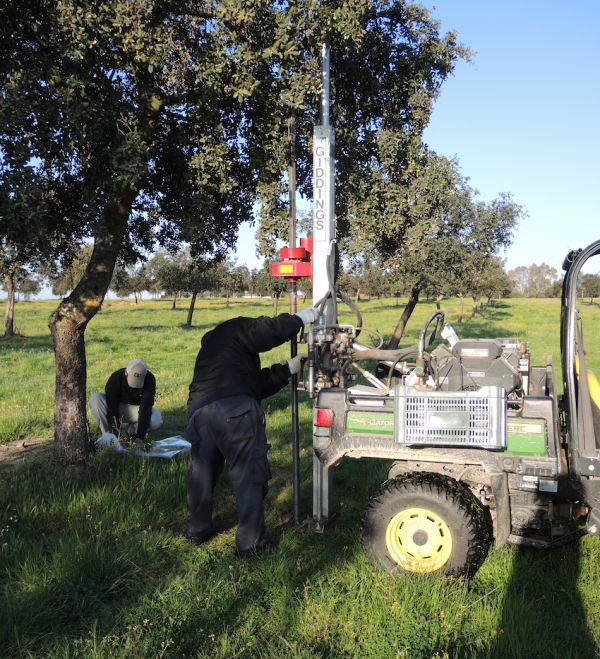The dehesa is an ecosystem that covers around four million hectares in southwestern Andalusia. This ecosystem, including trees, pastures and livestock, provides a series of ecosystemic services among which we can find carbon fixation, which entails a reduction in the presence of CO2 in the atmosphere. The dehesa can accumulate amounts from 25 to 75 tons of organic carbon per hectare.
However, organic carbon storage and dynamics in soil depends on the region, the kind of soil, weather conditions and soil management. Given the lack of previous studies that measure the distribution the concentration of organic carbon in the dehesa in depth, a research team at the University of Cordoba made up of Lizardo Reyna, Jesús Fernández Habas and led by Professor Pilar Fernández, along with an Institute for Sustainable Agriculture (of the Spanish National Research Council) research team, led by José Alfonso Gómez, delved deeply into analyzing the distribution of carbon in soil in two types of areas in the dehesa that used different kinds of soil management. A similar concentration of carbon was found in the two areas.
The plots of land that were chosen are described below. One had been used for temporary crops but currently is used as permanent pasture. This was a dehesa with young Holm oaks (planted in 1995), and grazed by sheep since 2000 (six months a year). Prior to this, it had been managed in the same way as the second area assessed in the study: an adjacent dehesa with older Holm oaks spaced out farther apart between which a mixture of vetch and oats are grown every three years and is plowed with a chisel plow (a tool which hoes the soil, without turning it, mixing it superficially with plant debris). How carbon sequestration in the soil was altered due to this change that took place 22 years ago was under analysis.
After 22 years, carbon distribution in the soil in the two dehesas was similar, with approximately 40 tons per hectare in the top 100 cm of soil. The difference in soil management is only reflected in an increase in the amount of organic carbon at the soil’s surface, which was greater in the dehesa that had changed when it ceased to grow crops and be plowed. In the plot with crops, the presence of older trees significantly modified the distribution of organic carbon in the soil in its surroundings, increasing the relevance of the unprotected fraction, which is the organic material that remains for less time in the soil, since it is more degradable. In contrast, under the canopy of trees planted in 1995, the concentration of organic carbon was similar to that of the clearings.
As Pilar Fernández explains, more than 22 years would be needed for the trees to substantially affect and modify the organic carbon in the soil around them. Meanwhile, this study has made a contribution to research with its rigorous quantification of the total content of organic carbon in dehesas in typical Mediterranean environments.
Reyna-Bowen, L., Fernandez-Rebollo, P., Fernández-Habas, J., Gómez, J.A. (2020) The influence of tree and soil management on soil organic carbon stock and pools in dehesa systems. CATENA. Vol. 190. ISSN 0341-8162. https://doi.org/10.1016/j.catena.2020.104511


